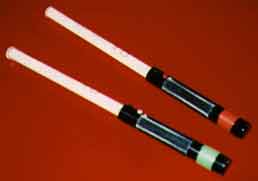| back to index | |||
H17 One Input Device * |
|||
 Lightning II infrared batons (by Buchla and Associates) used in the WorldBeat exhibit. |
|||
|
....you have found a way to create an interface adequate for the
domain of your system - Domain-Appropriate Devices that looks interesting to
use - Innovative Appearance. Now is the
time to see whether the various input channels can be simplified, so
that the number of devices that the user needs to see may be
reduced - Invisible Hardware.
|
|||
|
* * *
|
|||
| Many interactive systems require a variety of different
input devices to be used. Some systems may be able to recognize
gestures without any physical input device to touch. But interactive
exhibits are used by people with no prior experience with the system
who are confused by a large number of input devices, and feel uneasy
with no device at all.
|
|||
| WorldBeat: From many to few devices |
The initial interface design sketches for the WorldBeat system included the following devices:
The list partially reflected our desire to integrate advanced features into the system. An example is the piano keyboard, which we originally planned as an alternative interface for professional musicians. We later removed those devices to achieve simplicity and arrive at a system understandable for the average short-time visitor. However, the list also contained devices that we simply assumed as necessary for a computer-based exhibit, such as mouse and computer keyboard, for example to let visitors select items on screen or enter their names. Such functions were later mapped to the batons (such as item selection), or turned out not to be necessary for the exhibit (such as typing in information). The final user interface was reduced to just include batons, microphone, and monitor. Computer keyboard and mouse are hidden in a cabinet for maintenance, and a professional piano keyboard is stored elsewhere, but can be connected for special events or occasions. |
||
| Interactive Fugue: From text to photo |
In the Interactive Fugue system, we used a similar approach, and replaced the feature to enter names by a digital photo of the user that is automatically taken. $ |
||
| Zero input devices? |
With WorldBeat, it would have been possible to go even further, and use gesture recognition instead of a physical input device. Just waving their arms around, however, makes many people feel insecure and silly; it turns out that most users like having something in their hands that shows their purpose when interacting. Using just one instead of several devices, if sufficient for the task, is in accordance with standard usability heuristics, such as the principle of Simple and Natural Dialogue: "User interfaces should be simplified as much as possible, since every additional feature or item of information on a screen is one more thing to learn, one more thing to possibly misunderstand, and one more thing to search through when looking for the thing you want." [Nielsen, 1993, p. 115]. |
||
|
Therefore: Give the user one input device to use your interactive exhibit - no less, and no more if possible. Simplify your interaction requirements until all interaction easily maps to this device. |
|||
 |
|||
|
* * *
|
|||
| Make sure that the device you decide to leave in your
system is still reminiscent of the application
area - Domain-Appropriate Devices.
|
|||
This pattern is taken from the book "A Pattern Approach to Interaction Design" (PAID) by Jan Borchers (John Wiley and Sons, Chichester, UK, 2001). Copyright 2001 John Wiley and Sons. Used by permission. See http://media.informatik.rwth-aachen.de/paid.html for more information. Online version by Susan Babutzka, ETH Zurich (subabutz_at_student.ethz.ch). |
|||